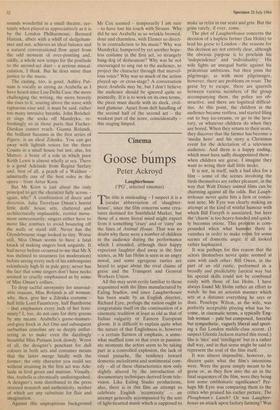Cinema
Goose bumps
Peter Ackroyd
Laughterhouse ('PG', selected cinemas)
he title is misleading — I suspect it is a .1 jocular abbreviation of 'slaughter- house', since the film concerns some crea- tures destined for Smithfield Market, but those of a more literal mind might expect from it something 'crazy' and or 'zany' on the lines of Animal House. That was no doubt why there were a number of children in the audience during the performance which I attended, although their happy expectant laughter died away in the first scenes, as Mr Ian Holm is seen in an angry mood, and some egregious rustics are heard to argue about the rival claims of geese and the Transport and General Workers Union.
All this may seem eerily familiar to those acquainted with the films manufactured by Ealing Studios, and since Laughterhouse has been made by an English director, Richard Eyre, perhaps the nation ought to congratulate itself on the continuation of a cinematic tradition at least as old as that of Italian vulgarity or Eastern European gloom. It is difficult to explain quite what the nature of that Englishness is, however — a certain flatness of emphasis, a some- what muffled tone so that even in passion- ate moments the actors seem to be taking part in a controlled explosion, the lack of visual panache, the tendency toward domestic melodrama and sentimental com- edy — all of these characteristics now only slightly altered by the introduction of documentary techniques derived from tele- vision. Like Ealing Studio productions, also, there is in this film an attempt to celebrate English 'eccentricity' — an attempt generally accompanied by the sort of light-hearted music which is supposed to
make us relax in our seats and grin. But the grins rarely, if ever, come.
The plot of Laughterhouse concerns the decision of a hapless farmer (Ian Holm) to lead his geese to London — the reasons for this decision are not entirely clear, although the obvious purpose is to proclaim his 'independence' and 'individuality'. His wife fights an unequal battle against his pedestrian ambitions, but then joins the pilgrimage; as with most pilgrimages, however, there are problems en route. The geese 'try to escape, there are quarrels between various members of the group accompanying them, the police are ob- structive, and there are logistical difficul- ties. At this point, the children in the audience became restless, and started filing out to buy ice-creams, or go to the lava- tory, or whatever children do when they are bored. When they return to their seats, they discover that the farmer has become a 'media hero' and his story a Christmas event for the delectation of a television audience. And there is a happy ending, which must have sadly disappointed them : when children see geese, I imagine they want to wring their dull little necks.
It is not, in itself, such a bad idea for a film — some of the scenes involving the birds themselves are rather pleasant, in the way that Walt Disney animal films can be charming against all the odds. But Laugh- terhouse never quite hits a firm or consis- tent note; Mr Eyre was clearly making an attempt at the kind of wistful humour with which Bill Forsyth is associated, but here the 'charm' is too heavy-handed and quick- ly becomes otiose. This problem is com- pounded when what humour there is vanishes in order to make room for some scenes of domestic angst: it all looked rather haphazard.
It was perhaps for this reason that the actors themselves never quite seemed at ease with each other: Bill Owen, in the part of an old rustic, performed in a broadly and predictably farcical way but his special skills could not be combined easily with those of Ian Holm. I have always found Mr Holm rather an effort to watch: he has an actorish manner which sets at a distance everything he says or does. Penelope Wilton, as the wife, was perfectly acceptable playing what has be- come, in cinematic terms, a typically Eng- lish woman — pale but composed, forceful but sympathetic, vaguely liberal and sport- ing a flat London middle-class accent. (I suspect Glenda Jackson started this trend.) She is 'nice' and 'intelligent' but in a rather dull way, and in that sense might be said to represent the soul of the film itself.
It was almost impossible, however, to discern quite what the film's intentions were. Were the geese simply meant to be geese or, as they flew into the air in the final sequences of the film, were they being lent some emblematic significance? Per- haps Mr Eyre was comparing them to the critics who praised his earlier picture, The Ploughman's Lunch? Or was Laughter- house an attack upon factory farming? Was
it even the fable of one man pitting himself against the powers of various institutions, apparently including the BBC and the TGWU? It was difficult to be sure, and the inexplicable convolutions of the plot (assisted by some very awkward editing) did not make the task any easier. What we got, in the end, was something which might be called a 'warm' and 'human' comedy, pleading for something described as 're- spect for livestock'. It would be nice to respond in a 'warm' and 'human' manner also, but the film was so obviously set up to elicit such responses that the heart turned to stone.











































 Previous page
Previous page